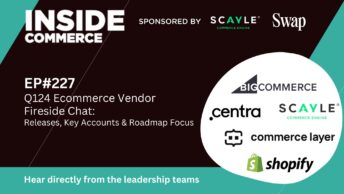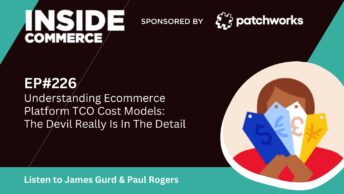In this episode James and Paul share advice and guidance on aligning design & development agencies when you work with different partner, to minimise the risk of designs not being fit for purpose and build phases over-running.
Listen on your favourite player
Watch the video
It’s common for the chosen SI (systems integrator) partner for a replatforming project to provide design resource and manage the development project end-to-end. However, not all agencies have sufficient depth of design skill or breadth of experience to satisfy the client’s needs, especially for luxury brands where brand experience is as important to the project as the ecommerce functionality. In this scenario, the client will partner with a design specialist to deliver visual designs to the development agency.
Each approach has its own set of pros and cons, and in this ecommerce podcast episode we’re talking about how to align design & dev agencies to minimise the risk of designs not being fit for purpose or adding unnecessary cost to the build phase to shoehorn visual designs into an ecommerce platform and set of front-end templates.
Tl;dr – what we cover:
- Pros and cons for separating design and development
- Running an efficient design phase including kick offs and briefing
- Aligning design with development for your happy path
Key Discussion Points
- Risks of separating out design and development:
- Increased cost
- Dev agency doesn’t usually love it
- Harder to manage
- Agencies haven’t worked together before, so no process for seamlessly pushing design into dev
- Design agency not understanding implications of visual designs based on functional requirements e.g. user journey flows for things like loyalty rewards, subscriptions
- Designers may not adequately understand interaction design for ecommerce, so may produce flat design that don’t translate well into mobile UX – seen this when the designs were so large, little content visible on the screen
- Forcing too many constraints on the designers based on how the dev agency works
- Not understanding tech stack + platform + frameworks etc.
- Benefits of this approach vs. all-in-one agency:
- Appoint specialists for each areas, get the most experienced resource
- Design agency will have broader design experience, reference set for inspiration
- Design agencies often more in-tune with customer insight & user experience design i.e. how people respond to designs
- Getting the design agency kick off right – scoping call and planning:
- Project team: who is involved, what are their roles & responsibilities, how will we work together?
- Project process for ecommerce designs: please map out each step and explain what/who is involved, how long it will take and what the deliverables are
- Briefing process: what are your expectations for the brief, what information do you need & why & how do you ensure you’ve understood the full set of requirements that have a design implication in sufficient detail?
- Design inputs: how do you factor in business and customer insight, what resources/skills do you have to ensure the design process is informed by data?
- UX/UI alignment: how do you work with development agencies to ensure the design planning delivers appropriate design artefacts the developer needs to build out the front-end? i.e. when would you want them involved?
- Tooling: what systems will we have access to for viewing/commenting on wireframes, visuals etc. – for example Figma or Adobe XD for design preview and review
- Sign off process: how many iterations and amends are included in your standard quote?
- Risk management: what are the common risks you encounter in ecommerce design project and how will you help us mitigate them?
- Expectations: what would make us and our dev agency good partners in this process – what are you expectations/needs so we are prepared e.g. resources?
- Getting the design agency brief fit for purpose:
- Goals and objectives
- Brand guidelines are essential (unless rebranding is part of the brief!) – what boundaries do they need to work within?
- Scope of work & deliverables
- Insight: relevant data like customer segments, customer feedback, business insights etc.
- Key customer segments, products and high traffic pages
- Inspirations – examples and explanation (equally what don’t you like and why)
- Requirements for key page types and user journeys
- Implications of 3rd party apps/plugins used e.g. loyalty app that has fixed flow and can’t customise only change branding, subscriptions etc.
- Aligning your dev partner with the design agency:
- Initiation meeting to define RACI and ways of working
- Let the design agency breathe – don’t put too many constraints on their creativity
- Dev to walk through platform limitations/constraints
- Let dev input at each stage of design when something is in review status e.g. IA, each page type, core user journeys > anything from a UX/UI POV that needs addressing?
- Final review of finished designs
- Ensuring design artefacts are appropriate for the dev stream:
- Agree output formats so dev can actually use the finished designs e.g. PDFs won’t cut it!
- Ensure dev has login to systems where source files are ideally
- Managing people, decisions and any conflicts:
- RACI
- Diary management and advance scheduling of milestone calls/meetings for reviewers/decision-makers
- Comms channels: keep comms open throughout e.g. Slack, Teams
- Regular check-ins with PM to manage the project plan
- Sign off process
- Escalation points
- Contingency in your timeframe to allow for issues or rework
Want to suggest a topic or guest for a future episode? Contact us via the website or on Twitter.







